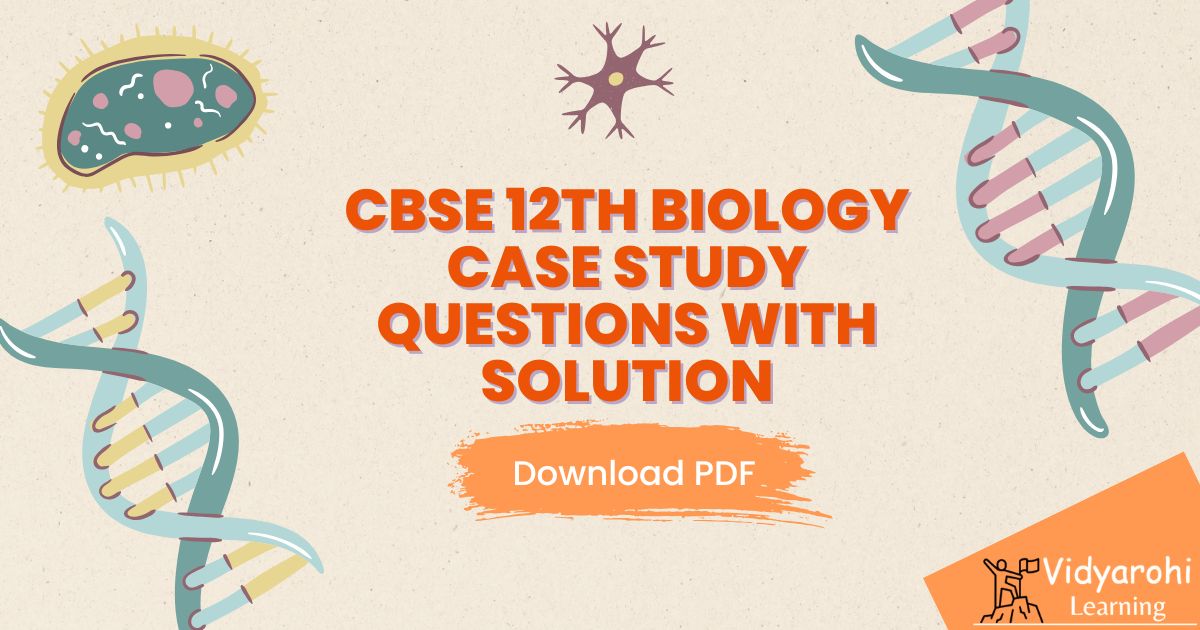CBSE 12th Biology Case Study Questions: In recent years, CBSE has added case study questions to the Class 12 Biology board exams to make learning more practical and useful. These questions do not just test memory or definitions but check how well students can use Biology concepts in real-life situations. This method helps students think deeply, analyse information, and improve problem-solving skills. It also builds a stronger foundation for competitive exams and higher studies by focusing on understanding instead of rote learning. For the 2025-26 academic year, case study questions will remain an important part of the Class 12 Biology paper because they test analytical and application-based skills. This article explains what Biology case study questions are, their format, examples, and preparation tips to help you study smartly and feel more confident in exams.
Also check,
What are CBSE Class 12 Biology Case Study Questions 2026?
CBSE Class 12 Biology Case Study Questions are not limited to bookish theory or memorised concepts. They are designed to connect classroom learning with real-life biological situations. With CBSE’s focus on competency-based assessments, these questions are becoming an essential part of the exam.
Case study questions in Biology are meant to test a student’s ability to:
- Apply biological concepts, processes, and principles in practical or everyday contexts.
- Analyse and interpret data, diagrams, charts, or experimental results.
- Solve problems that require reasoning, application, and critical thinking rather than rote memorisation.
Instead of direct numerical problems, these questions come with a short passage, situation, or case, followed by 3 objective or subjective questions related to that case.
Also check,
CBSE Class 12 Biology Case Study Question Format
According to the CBSE Class 12 Biology Paper Pattern 2026, the paper includes:
- 2 Case study-based questions, carrying 4 marks each.
- In Section D of the question paper
- Both the case study questions have three descriptive questions of 1 and 2 marks with one internal choice.
These questions require students to understand the given case, extract relevant information, and solve accordingly.
Important Chapters for Class 12 Biology Case Study Questions 2026
CBSE tends to pick case-based questions from chapters that lend themselves to real-world applications. Chapters from which Class 12 Case Study Questions that are commonly asked are listed below:
- Reproduction: Human Reproduction, Reproductive Health, Sexual Reproduction in Flowering Plants.
- Genetics and Evolution: Principles of Inheritance and Variation, Molecular Basis of Inheritance, and Evolution.
- Human Physiology: Excretory System, Endocrine System, Circulatory System, Nervous System, Digestive System.
- Ecology and Environment: Ecosystem, Biodiversity and Conservation, Environmental Issues.
- Plant Physiology: Photosynthesis, Plant Growth and Development.
Also check,
Importance of Case Study Questions in Class 12 Biology
Case study questions in Class 12 Biology are an important part of the CBSE Board Exam. They are designed to test not just theoretical knowledge but also the ability to apply concepts to real-life situations. These questions push students to think critically, analyse data, and develop problem-solving skills rather than simply memorising formulas. By practising case study questions, students gain a deeper understanding of Biology concepts and improve their exam performance. They also help reduce exam fear because students learn how to approach different types of problems with confidence.
- Encourages students to apply theoretical concepts to practical situations, understand experimental outcomes and real-life scenarios.
- Improves the ability to analyse data, graphs, and case-based situations logically.
- Enhances skills needed to solve multi-concept and integrated questions.
- Help students understand the utility of Biology in daily life
- Helps students understand concepts deeply instead of rote learning.
Tips to Solve Biology Case Study Questions Effectively
To solve Biology case study questions effectively, first read the question carefully and understand the real-life situation given. Identify the Biology concepts or formulas needed to solve it. Break the problem into small parts and solve it step by step. Practice similar questions regularly to improve speed and accuracy. Here are some expert tips for solving Class 12th Biology Case Study Questions effectively:
1. Read the Case Carefully: Understand the scenario completely before attempting to answer. Highlight key information such as symptoms, organisms, processes, or data provided.
2. Identify the Chapter and Concept: Determine which chapters or topics are being tested. Often, multiple concepts from different chapters are linked in one case study.
3. Highlight Key Data: Underline important definitions, scientific terms, or keywords to avoid confusion.
4. Break Down the Problem: Treat each sub-question individually. Don’t get overwhelmed by the case’s length; they are often easier than they look!
5. Use Diagrams Where Needed: Many CSQs can be solved faster and more accurately by drawing labelled diagrams, flow charts, or tables.
6. Pay Attention to Keywords: Words like “cause,” “effect,” “symptom,” “mechanism,” and “solution” guide you to the type of answer required.
7. Link Theory with Application: Don’t just write theoretical definitions; relate your answers to the case context to show understanding.
8. Write Clear, Short Answers: Keep your explanation simple and to the point to save time.
9. Practice from Sample Papers and Past Year Papers: Use the CBSE Sample Paper 2025 and previous years’ board papers to practice similar case-based questions.
CBSE Class 12 Biology Case Study Question
Let’s look at an example to understand how these questions appear:
Case No.1: Read the following and answer any four questions from (i) to (v) given below.
Packaging of DNA Helix
Each diploid human cell contains a genome of approximately 6 billion base pairs of DNA packaged into 23 pairs of chromosomes. Because each base pair is around 0.34 nanometers long, each diploid cell therefore contains about 2 meters of DNA. How is this chromosomal DNA compacted into the microscopic space of the eukaryotic nucleus? In eukaryotes, DNA is wrapped around an octamer of proteins known as histones to form structures called nucleosomes. H1, H2A, H2B, H3 and H4 are five major types of histones involved in eukaryotic DNA packaging. Each nucleosome is linked to the next one with the help of a linker DNA. This is also known as the “beads on a string” structure.
The following questions are multiple-choice questions. Choose the most appropriate answer:
(i) The histone octamer of a nucleosome is formed of
(a) two molecules each of H1, H2A, H2B and H3.
(b) two molecules each of H2A, H2B, H3 and H4.
(c) two molecules each of H2A, H2B and H3 and one molecule each of H1 and H3.
(d) one molecule each of H2A, H2B and two molecules each of H1, H3 and H4.
Answer: (b) two molecules each of H2A, H2B, H3 and H4.
(ii) Histones are rich in
(a) acidic amino acids.
(b) polar amino acids.
(c) basic amino acids.
(d) non-polar amino acids.
Answer: (c) basic amino acids.
(iii) DNA is wrapped tightly around the histone octamer due to the interaction of
(a) negative charges on DNA with positive charges on histone proteins.
(b) negative charges of histones with negative charges on DNA.
(c) positive charges on DNA with negative charges on histone proteins.
(d) positive charges on DNA with positive charges on histone proteins.
Answer: (a) negative charges on DNA with positive charges on histone proteins.
(iv) What does “bead” represent in “beads on string structure”?
(a) DNA
(b) Histone octamer
(c) Linker DNA
(d) Nucleosome
Answer: (d) Nucleosome
(v) Assertion: Chromatin appears as euchromatin and heterochromatin in a nucleus.
Reason: Euchromatin stains lightly and heterochromatin stains darkly.
(a) Both assertion and reason are true, and the reason is the correct explanation of the assertion.
(b) Both assertion and reason are true, but the reason is not the correct explanation of the assertion.
(c) Assertion is true, but reason is false.
(d) Both assertion and reason are false.
Answer: (b) Both assertion and reason are true, but the reason is not the correct explanation of the assertion.
Case No.2: A disease is an abnormal condition affecting a healthy living organism. It is broadly divided into infectious and non-infectious. Infectious diseases are caused by pathogens, such as bacteria, viruses, fungi, parasites and can be easily transmitted from one person to another. Hence it is also known as a contagious or communicable disease. Common Cold, Tuberculosis, flu, ringworm, and malaria are some examples of infectious diseases. Non-infectious diseases cannot be transmitted from one person to another and are called non-infectious diseases, it is also known as non-communicable diseases. These diseases can be caused by genetic disorders, unhealthy diets, lack of physical activity, excessive use of tobacco, drugs or alcohol and a few environmental factors.
Based on the above information, answer the following questions:
(i) Name the vector that spreads dengue and chikungunya disease.
(ii) What are the symptoms of pneumonia? Also, mention the names of pathogens for this disease in humans.
(iii) What are cancer-causing genes known as?
(iv) What is the main cause of Rheumatoid arthritis?
(v) Name the toxin that is released by Plasmodium-infected cells responsible for the chills and fever in the patient.
Answer:
(i) Dengue and chikungunya are vector-borne diseases that are spread by a mosquito vector called Aedes mosquitoes.
(ii) The common symptoms of pneumonia are difficulty in respiration, fever, chills, cough, and headache. In humans, pneumonia is caused due to bacteria Streptococcus pneumoniae and Haemophilus influenzae that infect the alveoli (air-filled sacs) of the lungs.
(iii) Cancer-causing genes are known as oncogenes. There are certain proto- oncogenes or cellular oncogenes that, under specific conditions, convert into tumour cells.
(iv) Rheumatoid arthritis is an autoimmune disorder in which body cells lose their ability to differentiate between self and foreign cells. In this disorder, the body cells start attacking self-cells due to some genetic or other reasons.
(v) The toxin that is released by the Plasmodium-infected cells, which is responsible for the chills and fever in the patient, is known as Haemozoin.
Q.No.3: Read the passage given below and answer the following questions:
Biodiversity is all the different kinds of life forms found in one area - the variety of animals, plants, fungi, and even microorganisms like bacteria that make up our natural world. Each of these species and organisms works together in ecosystems, like an intricate web, to maintain balance and support life. It supports everything in nature that organisms need to survive. It provides food, clean water, medicine, and shelter. But as humans put increasing pressure on the planet, using and consuming more resources than ever before, it risks upsetting the balance of ecosystems and losing biodiversity.
(i) Give one example of a species showing genetic diversity.
(ii) Why did the biologists not give any count on the number of prokaryotes?
(iii) What are the special characteristics that account for the higher biological diversity of the tropics?
(iv) Give the equation that represents the species-area relationship on a log scale.
(v) What are the identifying features that are shown by the stable community?
Answer:
(i) One species is the mango, having 1,000 different genetic varieties growing in India.
(ii) The biologists did not give any count on the numbers of prokaryotes because the conventional taxonomic methods are not suitable for identifying microbial species, and many species are simply not culturable under laboratory conditions.
(iii) Tropics are not subjected to frequent glaciations and have remained relatively undisturbed in past years; also, tropics are less seasonal, and there is more solar energy available in the tropics.
(iv) The equation is:
log S = log C + Z log A
where,
S = Species richness, A = Area
Z = slope of the line (regression coefficient)
C = Y-intercept
(v) A stable community should not show too much variation in productivity from year to year; it must be either resistant or resilient to occasional disturbances (natural or man-made), and it must also be resistant to invasions by alien species.
CBSE Class 12 Biology Case Study Question PDF [Free]
Click on the link provided below to download the CBSE Class 12 Biology Case Study Question PDF with answers for free without any login. Get the direct link to download the PDF.
| CBSE Class 12 Biology Case Study Question PDF | Download here |
| CBSE Class 12 Biology Case Study Question- Solution PDF | Download here |
Common Mistakes to Avoid In Biology Case Study Questions
- Skipping the passage: Students often directly jump to the question without understanding the context.
- Ignoring Units and Conversions: Forgetting to convert values into the same units (like mL to L or atm to Pa) results in calculation errors.
- Mixing Up Concepts: Applying formulas or reactions from the wrong chapter (e.g., using kinetics instead of thermodynamics).
- Memorising Without Understanding: Trying to rote-learn reactions instead of understanding the mechanism leads to confusion.
- Misinterpreting the case: Especially in word problems involving diagrams or figures.
- Not revising key formulas: Weak formula recall can ruin your answer.
- Lack of practice: These questions are relatively new, and many students aren’t used to them yet.
CBSE Class 12 Biology Syllabus 2025-26
The Central Board of Secondary Education (CBSE) has released the Biology Syllabus for Class 12 Science streams for the 2025-26 academic year. This Biology Syllabus outlines the course structure, chapters, and topics that students will need to study in the subject. The CBSE Class 12 Biology syllabus covers a wide range of topics, including Reproduction, Genetics, Biology & Human Welfare, Biotechnology & its Applications and Ecology and Environment. It is divided into units with specific weightage, helping students plan their preparation effectively. The unit-wise chapters and weightage are provided below:
| Unit No. | Unit Name | Chapter Name | Marks |
| I | Reproduction | Sexual Reproduction in Flowering Plants Flower structure Human Reproduction Reproductive Health |
16 |
| II | Genetics and Evolution | Principles of Inheritance and Variation Heredity and variation Molecular Basis of Inheritance Evolution |
20 |
| III | Biology and Human Welfare | Human Health and Diseases Microbes in Human Welfare |
12 |
| IV | Biotechnology and its Applications | Biotechnology - Principles and Processes Biotechnology and its Applications |
12 |
| V | Ecology and Environment | Organisms and Populations Ecosystems Biodiversity and its Conservation |
10 |
| Total | 70 | ||
| Practical | 30 |
Check the latest and detailed CBSE Class 12 Biology Syllabus 2025-26; Check Latest Unit-wise Weightage, Download PDF.
CBSE Class 12 Biology Exam Pattern 2025
CBSE has released the exam pattern and marking scheme for the 2025-26 academic year. Based on the official question paper design shared the board has followed the same exam pattern and marking scheme as in 2024-25. The CBSE Class 12 Biology board exam for 2025-26 will also consists of a theory paper of 70 marks and a Practical of 30 marks. The question paper was divided into five different sections:
| Section | Question Type | Number of Questions | Marks |
| A | Multiple Choice Questions & Assertion and Reason Questions (1 mark) | 16 | 16 |
| B | Very Short Answer (2 mark) | 5 | 10 |
| C | Short Answer (3 marks) | 7 | 21 |
| D | Case Study-Based Questions (4 marks) | 2 | 8 |
| E | Long Answer (5 marks) | 3 | 15 |
| Total | 33 | 80 | |
Check the latest and detailed CBSE Class 12th Biology Exam Pattern 2025-26 with Marking Scheme.


